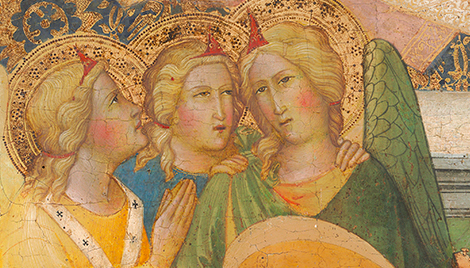Textile Conservation at the GWU Museum and The Textile Museum
In 2017 the George Washington University Museum and The Textile Museum was awarded a Kress Conservation Fellowship and choose Alison Castaneda as their Fellow. The following description of Ms. Castaneda’s accomplishments as Kress Conservation Fellow have been taken directly from the final report submitted by George Washington University Museum and The Textile Museum at the end of her tenure.
Alison Castaneda preparing an 18th century Ottoman tomb cover for exhibition.
George Washington University MuseumDuring her nine-month fellowship in the conservation department at the George Washington University Museum and The Textile Museum, Kress Conservation Fellow Alison Castaneda furthered her training in textile conservation under the supervision of Chief Conservator Maria Fusco and with guidance from Associate Conservators Elizabeth Shaeffer and Cathleen Zaret.
The fellowship provided Ms. Castaneda with a useful balance of exhibition and collections care experience, while also helping her development of skills in time and project management and interdepartmental coordination.
Among Ms. Castaneda’s many accomplishments as Kress Conservation Fellow, the most significant was her work as the lead conservator on the project to install a new rotation of permanent collection selections in the museum’s lower gallery. The permanent collection selections gallery ensures that visitors always have an opportunity to experience the breadth and depth of The Textile Museum’s collections, numbering more than 20,000 textile objects.
As lead conservator for this gallery, Ms. Castaneda took the exhibition through the full stages of object assessment, object discussion with the curatorial department, object treatment, mount preparation, packing for movement to the museum facility on campus, and installation. Some of the textiles were significantly damaged, and Ms. Castaneda worked closely with her supervisors to prepare the textiles through mending and washing, which allowed some objects to be on view for the first time in the museum’s new location. The result was a far-reaching exhibition that demonstrated how—across many cultures—written script or symbolic messages imbued textiles with special meaning.
The following highlights outline some of Ms. Castaneda other activities during her tenure as Kress Conservation Fellow:
- Among Ms. Castaneda’s primary duties during the fellowship was museum collection care. She learned about environmental monitoring, and how to observe fluctuations in temperature and relative humidity that may affect textiles.
- Especially important when working with textiles, Ms. Castaneda became familiar with integrated pest management and best practices and became knowledgeable in identifying museum pests and their behaviors.
- Ms. Castaneda worked on the installation of several exhibitions—an essential role that the conservation department plays in supporting the museum’s exhibition program. To determine the best way to display and install objects, she worked closely with curators, and fabricators, and developed skills in project management and coordination. Ms. Castaneda assisted in installing the spring 2018 exhibitions Vanishing Traditions: Textiles and Treasures from Southwest China, which involved construction of hat and jewelry exhibition mounts and dressing of minority ethnic group Chinese costume ensembles, and Binding the Clouds: The Art of Central Asian Ikat, which used temporary mounting techniques such as using Velcro hanging mechanisms for the large format objects of the Anatolian kilims and pressure mounts.
Festival jacket (front), China, Guizhou Province, Taijiang County, Miao people, 20th century. The Textile Museum 2015.8.158. The Bea Roberts Collection of Chinese Minority Textiles.
- New acquisitions to the museum collections gave Ms. Castaneda an opportunity for object-based research and rehousing. One new accession required Ms. Castaneda to conduct research into mold assessment and a review of fiber and finish identification techniques. A newly accessioned group of African headware gave Ms. Castaneda the opportunity to devise and implement a systematic method for group rehousing.
Ms. Castaneda at The Avenir Foundation Conservation and Collections Resource Center.
George Washington University MuseumAt the end of her fellowship term Ms. Castaneda received a job offer from the Museum at the Fashion Institute of Technology where she is currently an associate conservator.



